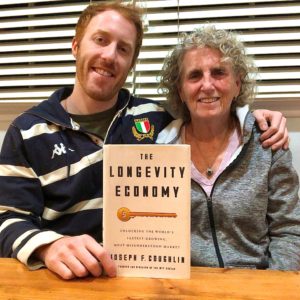 Over the next 30 years, the global population of people over the age of 65 will double to 16.7 percent. Japan, one of the oldest countries, will have an elderly population of approximately one-third of its total. In his book, Coughlin suggests that one of our biggest cultural flaws is looking at these stats as a problem. Elderly people are not a problem to be solved, but rather a vibrant community to be served. As the Baby Boomer generation embraces their later years, they are poised to redefine our cultural appreciation of what late life can look like.
Over the next 30 years, the global population of people over the age of 65 will double to 16.7 percent. Japan, one of the oldest countries, will have an elderly population of approximately one-third of its total. In his book, Coughlin suggests that one of our biggest cultural flaws is looking at these stats as a problem. Elderly people are not a problem to be solved, but rather a vibrant community to be served. As the Baby Boomer generation embraces their later years, they are poised to redefine our cultural appreciation of what late life can look like.
There are two main themes to this book. The first is the need to restructure our attitudes towards the final chapters of life. Over the past hundred years or so, Americans have come to associate retirement with the phase of life commencing after their career has ended and before they die. What to do with this seemingly empty time is a question that everyone must answer for themselves, but Coughlin posits that we are currently failing to help people answer this question adequately. This leads into the second theme, which is centered around the problem of keeping older people involved in the economy as both producers and consumers.
As it stands right now, products and technologies targeted at the older generation are pretty uninspiring. As long as we continue to view older adults as helpless consumers who need products that solely remind them to take their meds, they’re not going to want to buy. Older consumers generally want the same things that younger consumers do, i.e. products that support and promote a fun and engaging lifestyle. If they just so happen to also help them remember to feed the cat, so much the better. Many older people are still ambitious, both personally and professionally. Many still have the desire for new experiences in life and are still discovering new things about themselves. Some want to travel, some want to be caregivers for younger generations of their family, and many want to continue working past the age of 65 because they like their jobs. Believe it or not, they still have sex just like the rest of us. They deserve to have products on the market that make all of these aspects of their lives easier and more enjoyable.
A huge benefit to older people is the rise of modern technology and more specifically the smartphone. For example, Coughlin writes: “no recent technology has done more for deaf people than the text message.” It will come as no surprise to anyone that a majority of deaf and hard of hearing people are older. There also comes a time in many people’s lives when their eyesight becomes too poor to drive safely. Once upon a time, this meant isolation. Now, however, with apps like Lyft and Uber, a car is only moments away. If they don’t want to leave their house, anything and everything is deliverable today, including groceries and medications. Perhaps they are missing friends and family. No problem! Advancements in video communications like Skype, FaceTime, and Zoom can provide the antidote to loneliness. What if they need help installing a large television on the wall? There’s an app for that too. And what if an older person feels that they need a professional care provider? There are multiple apps on the market for on-demand in-home care as well.
One of the biggest gaps between marketplace producers and older consumers is not just age, but also gender. Silicon Valley, the heart of the tech industry, is overwhelmingly young men. Conversely, the majority of consumers are women, a large portion of which are older women, who often take on the role “of Chief Consumption Officer for two, three, or even four generations of people in their families. Add to that the sheer numerical advantage older women have over men” and you can see the disconnection. Part of the problem is that older people are often excluded from the marketplace of ideas. If someone is going to be creating products for consumers over the age of 65, shouldn’t that someone also be in the same demographic? As long as it is young men (and some women) creating products for older women (and some men), the marketplace will suffer.
So, how do we remedy this? To bring it full circle, we must start with redefining old age and what it means to ‘retire’ or to live through the final stages of life. As long as we see it as a problem to be fixed, older people will remain unhappy with their economic opportunities. Why have apps like Uber, Airbnb, and Postmates been so successful with older people? Because they are successful with everyone. Older people, obviously, are included in everyone. Further future successes will come from a deeper understanding of the wants and needs of older adults and the continual development of products and technologies that offer up fun and engaging ways to provide for them.


Leave a Reply